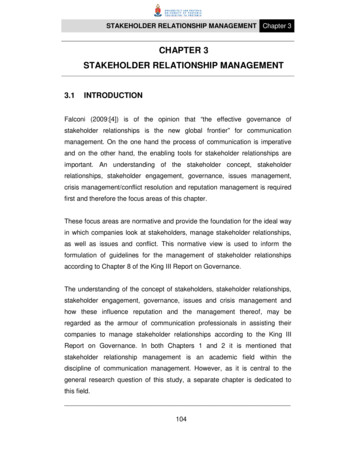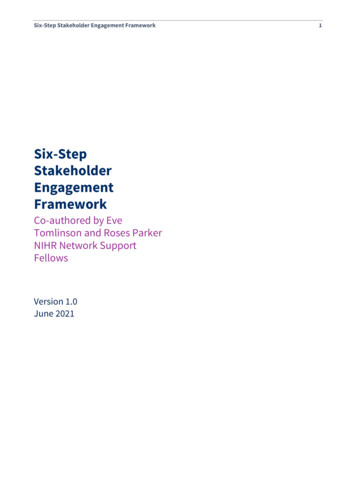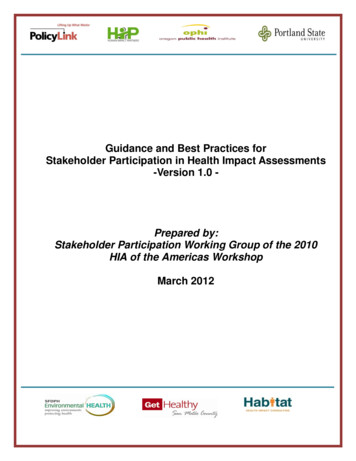
Transcription
Business Ethics Ethical Decision Making and Cases 9th Edition Ferrell Test BankFull Download: ll-test-bank/1Chapter 2—Stakeholder Relationships, Social Responsibility, and CorporateGovernanceMULTIPLE CHOICE1. Stakeholders' power over businesses stems from theira. ability to withdraw or withhold resources.b. ability to generate profits.c. media impact.d. political influence.e. stock ownership.ANS: APTS: 1REF: p. 322. Those who have a claim in some aspect of a firm's products, operations, markets, industry, andoutcomes are known asa. shareholders.b. stockholders.c. stakeholders.d. claimholders.e. special-interest groups.ANS: CPTS: 1REF: p. 313. Which of the following do not typically engage in transactions with a company and thus are notessential for its survival?a. Employeesb. Secondary stakeholdersc. Primary stakeholdersd. Investorse. CustomersANS: BPTS: 1REF: p. 334. A firm that makes use of a recognizes other stakeholders beyond investors, employees, andsuppliers, and explicitly acknowledges the two-way dialog that exists between a firm's internal andexternal environments.a. stakeholder model of corporate governanceb. stakeholder biasc. code of ethicsd. stakeholder interaction modele. corporate interface modelANS: DPTS: 1REF: p. 34 p. 35 2013 Cengage Learning. All Rights Reserved. May not be scanned, copied or duplicated, or posted to a publicly accessible website, in whole or in part.Full download all chapters instantly please go to Solutions Manual, Test Bank site: testbanklive.com
25. The degree to which a firm understands and addresses stakeholder demands can be referred to asa. a stakeholder orientation.b. a shareholder orientation.c. the stakeholder interaction model.d. a two-way street.e. a continuum.ANS: APTS: 1REF: p. 356. Which of the following industries tends to generate a high level of trust from consumers andstakeholders?a. Insuranceb. Technologyc. Banksd. Mortgage lenderse. Financial servicesANS: BPTS: 1REF: p. 327. Which of the following is not a benefit that primary stakeholders tend to provide to organizations?a. Supplies of capital and resources.b. Expertise and leadershipc. Word-of-mouth promotiond. Infrastructuree. Pro-bono bookkeepingANS: EPTS: 1REF: p. 328. A stakeholder group that is absolutely necessary for a firm’s survival is defined asa. direct.b. tertiary.c. secondary.d. special-interest.e. primary.ANS: EPTS: 1REF: p. 339. When unethical acts are discovered in a firm, in most instancesa. they are caused by unwilling participants.b. the cause is due to external stakeholders.c. the perpetrators are caught and prosecuted.d. there was knowing cooperation or complicity from within the company.e. the cause is a corrupt Board of Directors.ANS: DPTS: 1REF: p. 30 2013 Cengage Learning. All Rights Reserved. May not be scanned, copied or duplicated, or posted to a publicly accessible website, in whole or in part.
310. Which of the following is not a method typically employed by firms when researching relevantstakeholder groups?a. Surveysb. Focus groupsc. Internet searchesd. Press reviewse. GuessingANS: EPTS: 1REF: p. 3511. A stakeholder orientation can be viewed as a(n)a. necessity for business success.b. continuum.c. polarizing concept.d. good marketing ploy.e. expensive proposition.ANS: BPTS: 1REF: p. 3612. Shareholders provide resources to an organization that are critical to long term success. Which of thefollowing does the book suggest that suppliers offer?a. The promise of customer loyaltyb. Material resources and/or intangible knowledgec. Infrastructured. Revenuee. Leadership skillsANS: BPTS: 1REF: p. 3213. Which of the following is not associated with the stakeholder interaction model?a. Involves a two-way relationship between firm and stakeholdersb. Recognizes the input of investors, employees, and suppliersc. Explicitly acknowledges dialogue with a firm's internal environmentd. Explicitly acknowledges dialogue with a firm's external environmente. Identifies the mass media, special interest groups, competitors, and trade associations asprimary stakeholdersANS: EPTS: 1REF: p. 3514. The first of the three activities that are associated with the stakeholder orientation is thea. organization-wide generation of data.b. organization's responsiveness to intelligence.c. set of consumer attributes identified.d. organizational strategy of target markets.e. human relations department's set of priorities.ANS: APTS: 1REF: p. 35 2013 Cengage Learning. All Rights Reserved. May not be scanned, copied or duplicated, or posted to a publicly accessible website, in whole or in part.
415. Public health and safety and support of local organizations are issues most relevant to whichstakeholder group?a. Investorsb. Communityc. Suppliersd. Customerse. EmployeesANS: BPTS: 1REF: p. 3416. Minimizing the use of energy and reducing emissions and waste are issues of importance to whichstakeholder?a. Environmental groupsb. Suppliersc. Employeesd. Industry leaderse. InvestorsANS: APTS: 1REF: p. 3417. The idea that the mission of business is to produce goods and services at a profit, thus maximizing itscontribution to society is associated witha. Adam Smith.b. Theodore Levitt.c. Norman Bowie.d. Herman Millere. Milton Friedman.ANS: EPTS: 1REF: p. 3718. The originator of the idea of the invisible hand, which is a fundamental concept in free marketcapitalism, wasa. Adam Smith.b. Theodore Levitt.c. Norman Bowie.d. Herman Millere. Milton Friedman.ANS: APTS: 1REF: p. 3719. Some economists believe that if companies address economic and legal issues, they are satisfying thedemands of society, and that trying to anticipate and meet additional needs would be almostimpossible. Which economist’s theory are they following most closely with this belief?a. Adam Smith.b. Theodore Levitt.c. Norman Bowie.d. Herman Millere. Milton Friedman. 2013 Cengage Learning. All Rights Reserved. May not be scanned, copied or duplicated, or posted to a publicly accessible website, in whole or in part.
5ANS: EPTS: 1REF: p. 3720. argued that, although profits are required for business, profit is not the primary purpose ofbusiness.a. Adam Smithb. Theodore Levittc. Norman Bowied. Herman Millere. Milton FriedmanANS: BPTS: 1REF: p. 3821. Who argued that when a business also cares about the well-being of stakeholders, it earns trust andcooperation that ultimately reduce costs and increase productivity?a. Adam Smithb. Theodore Levittc. Norman Bowied. Herman Millere. Milton FriedmanANS: CPTS: 1REF: p. 3822. Enlightened capitalism is associated with which individual?a. Adam Smithb. Theodore Levittc. Norman Bowied. Herman Millere. Milton FriedmanANS: APTS: 1REF: p. 3823. A description of corporate social responsibility should include a list of all of the following excepta. corporate rights.b. corporate duties.c. environmentally friendly activities.d. consequences.e. values.ANS: CPTS: 1REF: p. 3824. In ascending order, Caroll's four levels of social responsibility area. ethical, legal, economic, philanthropic.b. economic, ethical philanthropic, legal.c. economic, legal, ethical, philanthropic.d. legal, ethical, economic, philanthropic.e. ethical, legal, moral, economic.ANS: CPTS: 1REF: p. 40 2013 Cengage Learning. All Rights Reserved. May not be scanned, copied or duplicated, or posted to a publicly accessible website, in whole or in part.
625. Which ISO guideline was established as a corporate responsibility regulation that is meant toencourage discussions on the role of social responsibility and the importance of stakeholders?a. ISO 3000b. ISO 2000c. ISO 265000d. ISO 26000e. ISO 14000ANS: DPTS: 1REF: p. 3926. Which ISO guideline pertains to environmental regulation standards and was designed to help reduce afirm's pollution, waste, and carbon footprint?a. ISO 3000b. ISO 2000c. ISO 265000d. ISO 26000e. ISO 14000ANS: EPTS: 1REF: p. 3927. The term used to express how a firm meets its stakeholder expectations of its economic, legal, ethical,and philanthropic responsibilities isa. reputation.b. corporate citizenship.c. corporate ethical audit.d. ethical citizenship.e. fiduciary duties.ANS: BPTS: 1REF: p. 4028. Which economist espoused a kind of Darwinian or “wild west” version of capitalism?a. Adam Smithb. Theodore Levittc. Norman Bowied. Herman Millere. Milton FriedmanANS: EPTS: 1REF: p. 37 2013 Cengage Learning. All Rights Reserved. May not be scanned, copied or duplicated, or posted to a publicly accessible website, in whole or in part.
729. In corporate governance, is the process of auditing and improving organizational decisions andactions.a. profitb. loyaltyc. accountabilityd. controle. diligenceANS: DPTS: 1REF: p. 4230. Accountability, oversight, and control all fall under the definition and implementation of corporatea. profit.b. loyalty.c. care.d. governance.e. diligence.ANS: DPTS: 1REF: p. 4231. Major corporate governance issues normally involve decisions. (Choose the response that ismost correct)a. strategic-levelb. tactical-levelc. divisional-leveld. marketing-levele. accounting-levelANS: APTS: 1REF: p. 4332. Which of the following is a major concern among corporate boards of directors?a. Compensationb. The non-traditional directorship approachc. Dividend reportingd. Corporate social auditse. Debt swapsANS: APTS: 1REF: p. 43 p. 4633. Why were the International Organization for Standardization (ISO) 26000 guidelines established?a. To promote a common understanding in the area of social responsibility.b. To provide organizations with another social responsibility certification.c. To educate organizations.d. To help organizations look good to stakeholders.e. To establish international environmental standards.ANS: APTS: 1REF: p. 39 2013 Cengage Learning. All Rights Reserved. May not be scanned, copied or duplicated, or posted to a publicly accessible website, in whole or in part.
834. One policy to address the issue of executive pay was implemented by J.P. Morgan, it stated thata. there should be no limit on what top executives can earn.b. managers should earn no more than twenty times the pay of other employees.c. top managers should make the same amount as other employees.d. employees can determine how much managers make.e. the government should determine the worth of each manager’s service.ANS: BPTS: 1REF: p. 4735. The specific steps for implementing the stakeholder perspective do not include which of thefollowing?a. Identifying stakeholder groupsb. Identifying stakeholder issuesc. Identifying and gaining stakeholder feedbackd. Identifying and gaining government feedbacke. Assessing organizational commitment to social responsibility groupsANS: DPTS: 1REF: p. 48-5136. What are the four levels of social responsibility?a. Financial, religious, ethical, and philanthropicb. Ethical, philanthropic, selfish, and short-sightedc. Economic, long-term, ethical, and philanthropic.d. Legal, economic, ethical, and philanthropice. Economic, compliance, legal, and philanthropicANS: DPTS: 1REF: p. 4037. The model is founded in classic economic precepts.a. economicb. shareholderc. stakeholderd. boarde. ISOANS: BPTS: 1REF: p. 4438. Which of the following are not typically secondary stakeholders?a. Television news anchorsb. Special-interest groupsc. Customersd. Trade associationse. JournalistsANS: CPTS: 1REF: p. 33 2013 Cengage Learning. All Rights Reserved. May not be scanned, copied or duplicated, or posted to a publicly accessible website, in whole or in part.
939. Which of the following are not typically primary stakeholders?a. Customersb. Trade associationsc. Employeesd. Shareholderse. InvestorsANS: BPTS: 1REF: p. 3340. Why do critics argue that high compensation for boards of directors is a bad thing?a. It is too expensive for the organization.b. It could cause conflicts of interest between the directors and the organization.c. It is not fair to poorly compensated employees.d. High pay will render the board less complacent.e. Board of director compensation is not a major issue.ANS: BPTS: 1REF: p. 4641. Board members being linked to more than one company is an example ofa. strategic philanthropy.b. stakeholder commitment.c. interlocking directorate.d. conflict of interest.e. an illegal activity.ANS: CPTS: 1REF: p. 4642. What is the first step in implementing a stakeholder perspective in an organization?a. Identifying resources and determining urgencyb. Identifying stakeholder groupsc. Identifying stakeholder issuesd. Assessing the corporate culturee. Assessing organizational commitment to social responsibilityANS: DPTS: 1REF: p. 4943. A stakeholder orientation is not complete unless it includesa. clear accounting procedures.b. major financing activities.c. marketing strategy.d. feedback from special-interest groups.e. activities that actually address stakeholder issues.ANS: EPTS: 1REF: p. 36 2013 Cengage Learning. All Rights Reserved. May not be scanned, copied or duplicated, or posted to a publicly accessible website, in whole or in part.
Business Ethics Ethical Decision Making and Cases 9th Edition Ferrell Test BankFull Download: ll-test-bank/10ESSAY44. Compare and contrast the stakeholder and shareholder models.ANS:Pages 44-45PTS: 1REF: p. 44-4545. What methods do special interest groups use to force organizations to alter their products or changetheir practices?ANS:Page 31PTS: 1REF: p. 3146. Why is ethical misconduct more difficult to overcome than poor financial performance?ANS:Page 31PTS: 1REF: p. 3147. Discuss the difference between primary and secondary stakeholders in the stakeholder interactionmodel and give examples for each type.ANS:Pages 33-34PTS: 1REF: p. 33-3448. Why do some businesspeople and scholars question whether ethics should have a role in business?ANS:Page 37PTS: 1REF: p. 3749. Discuss three corporate governance issues, why they are defined as issues, and how you would solvethem. Use examples in your answer.ANS:Page 42-43PTS: 1REF: p. 42-43 2013 Cengage Learning. All Rights Reserved. May not be scanned, copied or duplicated, or posted to a publicly accessible website, in whole or in part.Full download all chapters instantly please go to Solutions Manual, Test Bank site: testbanklive.com
20. _ argued that, although profits are required for business, profit is not the primary purpose of business. a. Adam Smith b. Theodore Levitt c. Norman Bowie d. Herman Miller e. Milton Friedman ANS: B PTS: 1 REF: p. 38 21. Who argued that when a business also cares about the well-being of stakeholders, it earns trust and











